Spanish Chapbooks
This is the contagion, the wretched contagion, that comes down from literature to the common people." Ramón del Valle-Inclán, Los cuernos de don Friolera (1921)
What sort of holdings should a library have? This question could well have been raised when Cambridge University Library and the British Library acquired items for their extensive holdings of ephemeral literature printed in Spain. This material, not obviously 'serious' or 'academic', and recently termed 'no-books' by a French colleague, was assiduously collected for the two libraries by a small number of enthusiasts. It is now available to all, as a digital, searchable collection, via the web-pages of the CUL and BL. Usually referred to in English as chap-books, and in Spanish as sueltos , or pliegos sueltos (loose leaves or folded loose leaves), these predecessors of the yellow press provide a fascinating bird's eye view of popular culture from the eighteenth century onwards. Cambridge University Library provided some 2,000 sueltos , including nearly 200 poster-sized aleluyas , which typically have 48 illustrations and accompanying text in couplets, and some 2,500 19 and late 18 century sueltos from the British Library. Many researchers have been unaware of the rich holdings these libraries have of this material.
Although they are numerous, the sueltos have received relatively little attention, not least because understanding this field as a whole has been difficult. Even where catalogue entries existed, they were insufficient for researchers to scan the material for themes or characteristics, or to view detail of the corpus against the background of the larger whole. Digitising and cataloguing the sueltos has contributed clearly to the stewardship and conservation of this material. But more than this, it opens the way for a new wave of activity. We can 'read all about it': we can read of gory crimes, heroic criminals, and wayward citizens at our pleasure. Not only can we 'read all about it', but all can participate in the reading. The accessibility of this material under an open license enables people to see and use these fascinating items from all over the world, at any point where internet access is available to the webpages of CUL or BL. Meanwhile, the catalogue makes it much easier to work with these sources, and to compare them with the material held in other libraries.
The collection was catalogued and digitised for the AHRC-funded project 'Wrongdoing in Spain 1800-1936: Realities, Representations, Reactions' (2011-2014). The project focused on particular aspects of the cultural representation of wrongdoing and its relation (or lack of it) to historical realities at the time of production. The material in this collection provides a unique base for tracking such interests within the field of popular literature, and in addition will enable the exploration of other themes, not just that of 'Wrongdoing'.
Two major questions arise when looking at this material. Firstly, it makes us think about right and wrong. Considering it in the context of 'wrongdoing', we are stimulated to think just what is involved in such a flexible term (even though we probably hear it used on the radio on a daily basis). The concept of 'wrongdoing' encompasses not just crime, but takes us into the area of the moral understanding of right and wrong, the transgression of social norms, and religious concepts of sin. The sueltos open up the potential for thinking about this broad topic, and to consider the social and cultural responses it has elicited over time. Such responses include anxiety, the desire for retribution, and the ways in which the reader or spectator might identify with (or decide to stand apart from) perpetrators or victims. Most of all it raises the question of why we are interested in a type of culture that tends to specialize in the shocking or the unsavoury, or why, as cultural consumers, we take a type of pleasure in the wrongdoing of others.
There is a second major question: how far does this material represent what is 'real', and how far does it consist of the work of the imagination? There is a distinct lack of information about the historical reality (or otherwise) of the people and events who appear in the sueltos . Even when they are given names and place of birth, and even when dates are given for the events recounted, such information is no guarantee of historical reality. But they constitute a cultural reality: this is what people read about. This is what they had instead of cheap newspapers, or reality TV. As with the media today, images are used to attract attention. The striking image shown here, of a collection of animals attacking a person (sex unclear), holds our attention because of its graphic and grisly detail. It reflects what will be the moral punchline of the story it accompanies, that of the 'unfortunate' Teresa, whose lack of charity to Christ who appeared at the door in the guise of a pauper led to her violent death. It would appear this story was something of an urban myth: but it is only possible to conclude it by having access to the many and somewhat varied versions of the narrative.
A first glimpse of this material is available through two exhibitions. 'Read all about it!', where Spanish material is set alongside with analogous English popular material available online at https://exhibitions.lib.cam.ac.uk/wrongdoing/ . Its narrative follows a type of life-cycle of wrongdoing, from education to (in some cases) execution. Meanwhile a Facebook gallery is available at the British Library, 'Wrongdoing meets modernity', in which the focus is on evolving ideas about crime and the poor in 19th-century Spain, and on the idea of wrongdoing being seductive and exciting.





